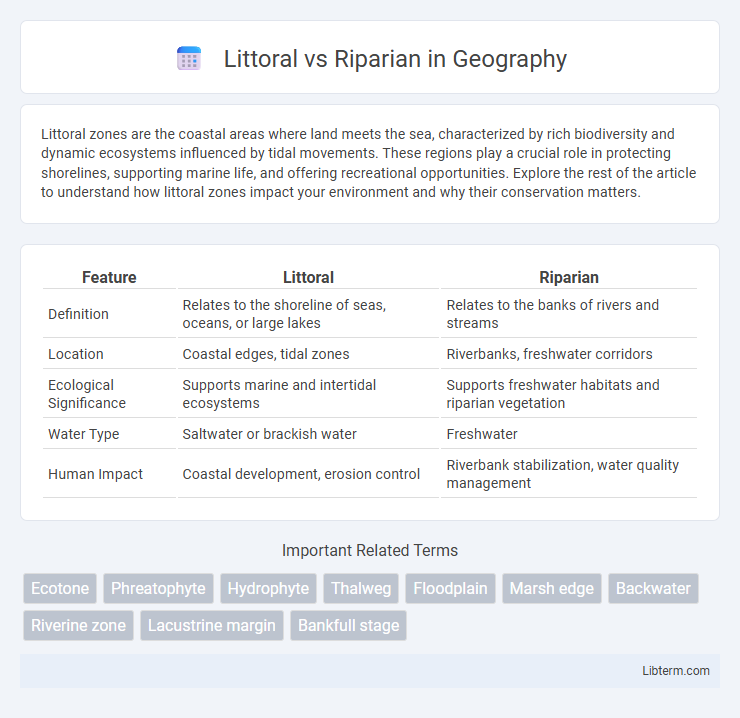Littoral zones are the coastal areas where land meets the sea, characterized by rich biodiversity and dynamic ecosystems influenced by tidal movements. These regions play a crucial role in protecting shorelines, supporting marine life, and offering recreational opportunities. Explore the rest of the article to understand how littoral zones impact your environment and why their conservation matters.
Table of Comparison
| Feature | Littoral | Riparian |
|---|---|---|
| Definition | Relates to the shoreline of seas, oceans, or large lakes | Relates to the banks of rivers and streams |
| Location | Coastal edges, tidal zones | Riverbanks, freshwater corridors |
| Ecological Significance | Supports marine and intertidal ecosystems | Supports freshwater habitats and riparian vegetation |
| Water Type | Saltwater or brackish water | Freshwater |
| Human Impact | Coastal development, erosion control | Riverbank stabilization, water quality management |
Understanding Littoral and Riparian Zones
Littoral zones refer to the coastal areas where land meets a body of water, especially oceans and large lakes, characterized by tidal influences and diverse marine ecosystems. Riparian zones are the interfaces between terrestrial and freshwater ecosystems, typically found along riverbanks and streams, playing a critical role in water quality and habitat stability. Understanding these zones involves recognizing their unique ecological functions, biodiversity contributions, and their importance in watershed management and conservation.
Key Definitions: Littoral vs Riparian
Littoral refers to the coastal zone adjacent to shorelines, primarily influenced by tidal, wave, and marine processes. Riparian describes the interface between terrestrial and freshwater ecosystems along rivers, streams, and lakeshores, crucial for regulating water quality and providing habitat. Understanding littoral vs riparian distinctions aids in effective ecosystem management, hydrological studies, and conservation practices.
Ecological Functions of Littoral Zones
Littoral zones provide critical ecological functions such as habitat provision for diverse aquatic plants, invertebrates, and fish, supporting biodiversity and food webs in freshwater ecosystems. These zones act as natural filters, improving water quality by trapping sediments and absorbing nutrients, which helps reduce eutrophication. Their vegetation stabilizes shorelines, preventing erosion and buffering the impacts of waves and storms.
Ecological Roles of Riparian Areas
Riparian areas play a crucial ecological role by serving as vital buffers that protect waterways from sediment and nutrient runoff, improving water quality and supporting diverse plant and animal habitats. They provide essential corridors for wildlife movement and contribute to the stabilization of stream banks, reducing erosion and enhancing aquatic ecosystems. The vegetation in riparian zones also regulates microclimates and supports carbon sequestration, making these areas key to maintaining ecosystem resilience and biodiversity.
Habitat Differences Between Littoral and Riparian Zones
Littoral zones are found along lake shores where sunlight penetrates to the bottom, supporting diverse aquatic vegetation and providing critical habitat for fish, amphibians, and invertebrates. Riparian zones occur along riverbanks and stream edges, characterized by dynamic water flow, which shapes nutrient-rich soils supporting trees, shrubs, and a variety of terrestrial wildlife such as birds, mammals, and insects. The habitat differences stem from littoral zones being primarily aquatic with submerged plants, while riparian zones serve as transitional ecosystems between aquatic and terrestrial environments, fostering species adapted to fluctuating water levels and shaded conditions.
Plant and Animal Life: Contrasts and Similarities
Littoral zones, located along oceanic or large lake shores, host salt-tolerant plants such as mangroves and sea grasses, while riparian zones, found along freshwater riverbanks, support diverse vegetation like willows and cottonwoods. Animal life in littoral areas includes marine species such as crabs, mollusks, and shorebirds, whereas riparian zones are inhabited by freshwater fish, amphibians, and mammals like beavers. Both ecosystems provide critical habitat and serve as biodiversity hotspots, supporting species adapted to fluctuating water levels and nutrient-rich environments.
Environmental Threats to Littoral and Riparian Zones
Environmental threats to littoral zones include shoreline erosion, pollution from runoff, and habitat loss due to recreational development and invasive species disrupting aquatic ecosystems. Riparian zones face challenges such as deforestation, agricultural encroachment, and altered water flow, which degrade water quality and reduce biodiversity. Both zones are critical for maintaining ecological balance but are increasingly vulnerable to human activities and climate change impacts.
Human Impacts on Littoral and Riparian Ecosystems
Human activities such as urban development, agriculture, and deforestation significantly disrupt littoral and riparian ecosystems by altering water quality, sediment flow, and habitat structure. Pollution from runoff and chemical contaminants leads to decreased biodiversity and impaired ecosystem services in these critical transitional zones. Restoration efforts targeting buffer zones and sustainable land use practices are essential to mitigate human impacts and preserve the ecological integrity of littoral and riparian environments.
Conservation Strategies for Littoral vs Riparian Zones
Conservation strategies for littoral zones emphasize protecting shoreline habitats and managing water quality to support aquatic biodiversity and prevent erosion. Riparian zone conservation focuses on preserving vegetation buffers along riverbanks to stabilize streambanks, filter pollutants, and maintain habitat connectivity for terrestrial and aquatic species. Implementing adaptive management practices tailored to the unique hydrological and ecological functions of each zone enhances their resilience against environmental threats.
Importance in Watershed Management
Littoral and riparian zones play critical roles in watershed management by enhancing water quality and providing habitat diversity. Littoral zones, located along lake and reservoir shorelines, support aquatic vegetation that stabilizes sediments and filters pollutants, reducing nutrient loading. Riparian zones, adjacent to rivers and streams, function as natural buffers that intercept runoff, regulate stream temperatures, and maintain ecological integrity essential for sustaining aquatic ecosystems.
Littoral Infographic

 libterm.com
libterm.com